HRMT20024, T1 2018 - Annotated Bibliography: HRM in Manufacturing
VerifiedAdded on 2023/06/14
|10
|2840
|410
Annotated Bibliography
AI Summary
This annotated bibliography presents a review of five peer-reviewed journal articles focusing on Human Resource Management (HRM) practices within the manufacturing sector. The articles cover various aspects of HRM, including enriched job design, high involvement management, the impact of HRM practices on organizational commitment, the causal relationship between HRM policies and organizational performance, and the impact of training and motivation on employee performance. Each annotation includes a summary of the article's main ideas, hypothesis, research methodology, and conclusions, followed by a critique of the article's usefulness in the context of studying the manufacturing sector. The bibliography highlights the crucial role of HRM in enhancing employee performance, achieving organizational goals, and gaining a competitive advantage in the manufacturing industry.
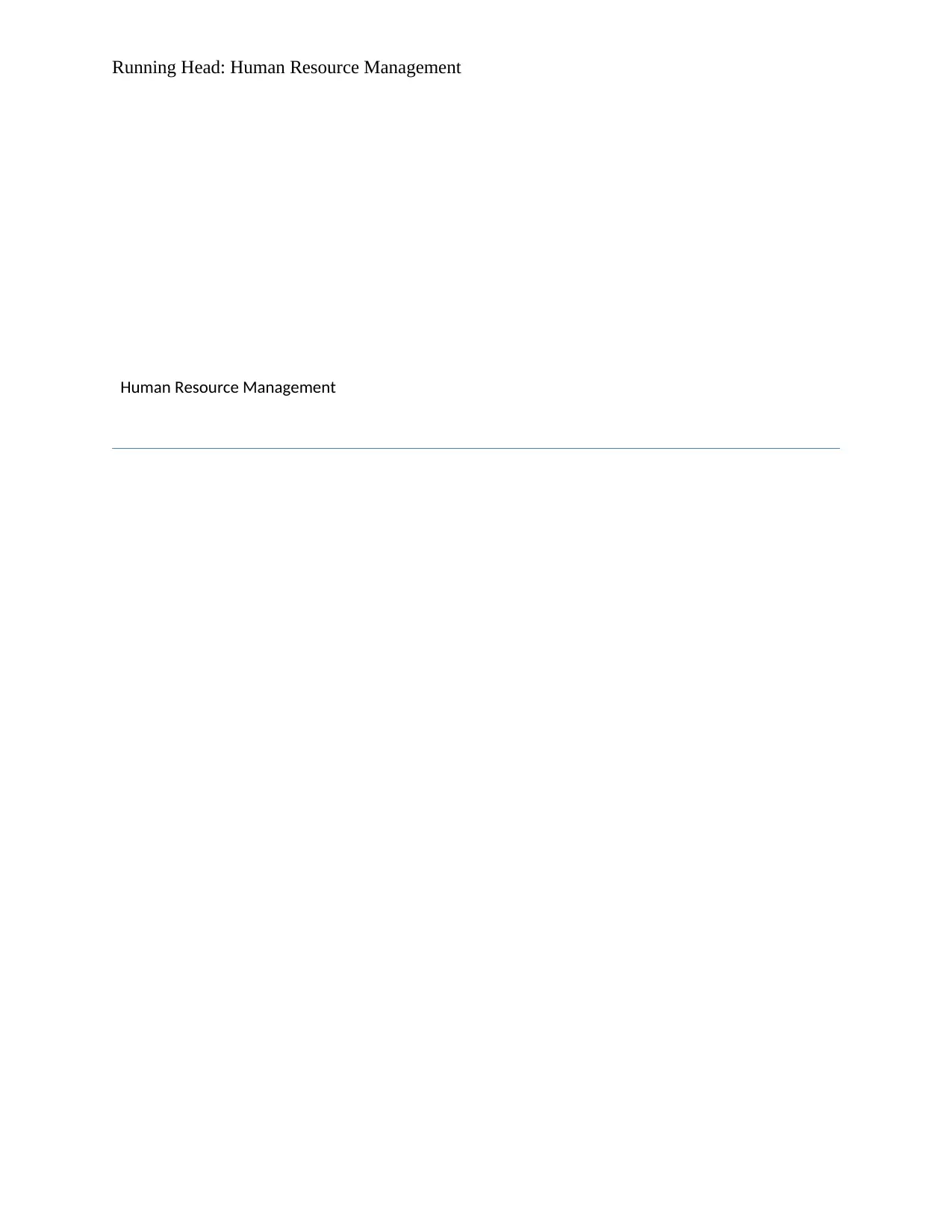
Running Head: Human Resource Management
Human Resource Management
Human Resource Management
Paraphrase This Document
Need a fresh take? Get an instant paraphrase of this document with our AI Paraphraser
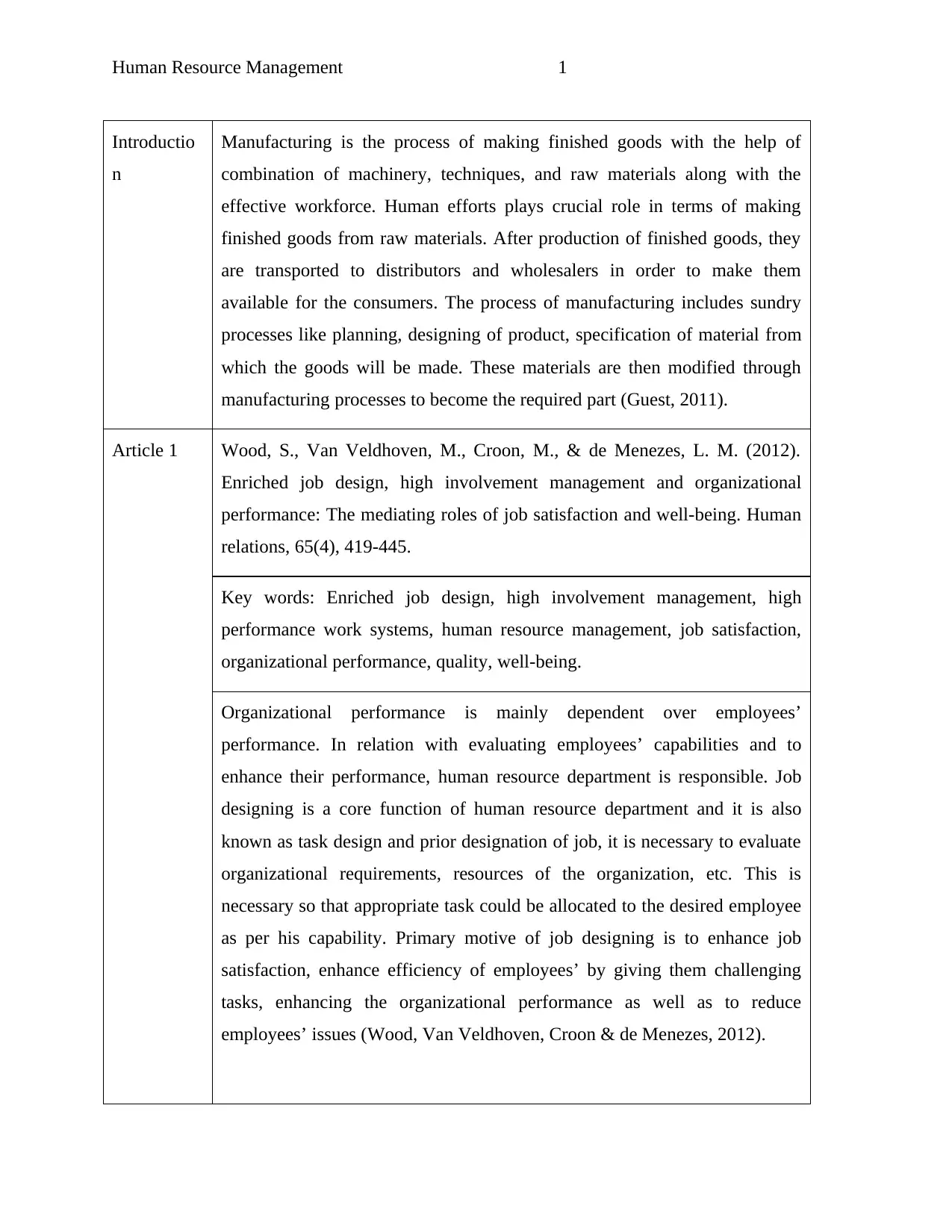
Human Resource Management 1
Introductio
n
Manufacturing is the process of making finished goods with the help of
combination of machinery, techniques, and raw materials along with the
effective workforce. Human efforts plays crucial role in terms of making
finished goods from raw materials. After production of finished goods, they
are transported to distributors and wholesalers in order to make them
available for the consumers. The process of manufacturing includes sundry
processes like planning, designing of product, specification of material from
which the goods will be made. These materials are then modified through
manufacturing processes to become the required part (Guest, 2011).
Article 1 Wood, S., Van Veldhoven, M., Croon, M., & de Menezes, L. M. (2012).
Enriched job design, high involvement management and organizational
performance: The mediating roles of job satisfaction and well-being. Human
relations, 65(4), 419-445.
Key words: Enriched job design, high involvement management, high
performance work systems, human resource management, job satisfaction,
organizational performance, quality, well-being.
Organizational performance is mainly dependent over employees’
performance. In relation with evaluating employees’ capabilities and to
enhance their performance, human resource department is responsible. Job
designing is a core function of human resource department and it is also
known as task design and prior designation of job, it is necessary to evaluate
organizational requirements, resources of the organization, etc. This is
necessary so that appropriate task could be allocated to the desired employee
as per his capability. Primary motive of job designing is to enhance job
satisfaction, enhance efficiency of employees’ by giving them challenging
tasks, enhancing the organizational performance as well as to reduce
employees’ issues (Wood, Van Veldhoven, Croon & de Menezes, 2012).
Introductio
n
Manufacturing is the process of making finished goods with the help of
combination of machinery, techniques, and raw materials along with the
effective workforce. Human efforts plays crucial role in terms of making
finished goods from raw materials. After production of finished goods, they
are transported to distributors and wholesalers in order to make them
available for the consumers. The process of manufacturing includes sundry
processes like planning, designing of product, specification of material from
which the goods will be made. These materials are then modified through
manufacturing processes to become the required part (Guest, 2011).
Article 1 Wood, S., Van Veldhoven, M., Croon, M., & de Menezes, L. M. (2012).
Enriched job design, high involvement management and organizational
performance: The mediating roles of job satisfaction and well-being. Human
relations, 65(4), 419-445.
Key words: Enriched job design, high involvement management, high
performance work systems, human resource management, job satisfaction,
organizational performance, quality, well-being.
Organizational performance is mainly dependent over employees’
performance. In relation with evaluating employees’ capabilities and to
enhance their performance, human resource department is responsible. Job
designing is a core function of human resource department and it is also
known as task design and prior designation of job, it is necessary to evaluate
organizational requirements, resources of the organization, etc. This is
necessary so that appropriate task could be allocated to the desired employee
as per his capability. Primary motive of job designing is to enhance job
satisfaction, enhance efficiency of employees’ by giving them challenging
tasks, enhancing the organizational performance as well as to reduce
employees’ issues (Wood, Van Veldhoven, Croon & de Menezes, 2012).
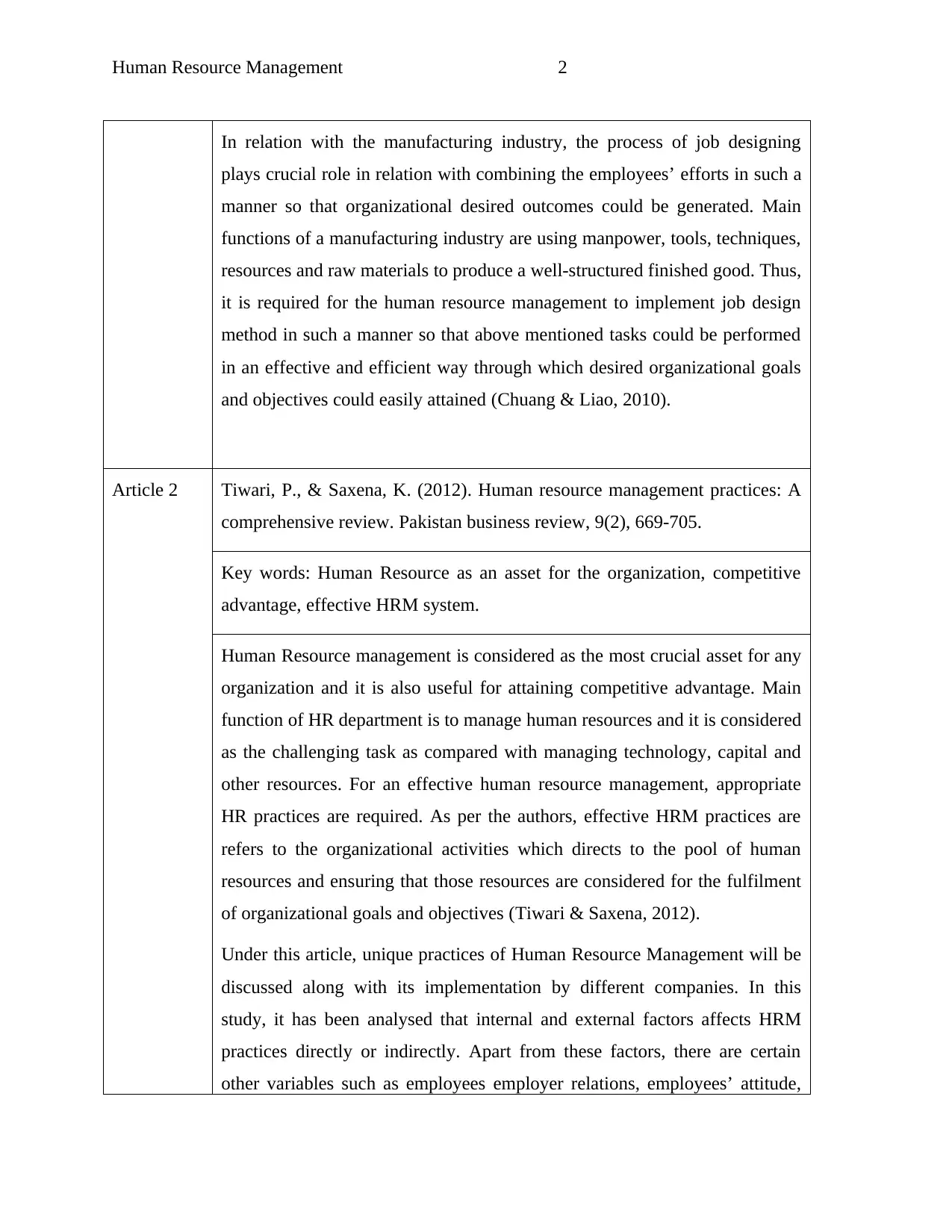
Human Resource Management 2
In relation with the manufacturing industry, the process of job designing
plays crucial role in relation with combining the employees’ efforts in such a
manner so that organizational desired outcomes could be generated. Main
functions of a manufacturing industry are using manpower, tools, techniques,
resources and raw materials to produce a well-structured finished good. Thus,
it is required for the human resource management to implement job design
method in such a manner so that above mentioned tasks could be performed
in an effective and efficient way through which desired organizational goals
and objectives could easily attained (Chuang & Liao, 2010).
Article 2 Tiwari, P., & Saxena, K. (2012). Human resource management practices: A
comprehensive review. Pakistan business review, 9(2), 669-705.
Key words: Human Resource as an asset for the organization, competitive
advantage, effective HRM system.
Human Resource management is considered as the most crucial asset for any
organization and it is also useful for attaining competitive advantage. Main
function of HR department is to manage human resources and it is considered
as the challenging task as compared with managing technology, capital and
other resources. For an effective human resource management, appropriate
HR practices are required. As per the authors, effective HRM practices are
refers to the organizational activities which directs to the pool of human
resources and ensuring that those resources are considered for the fulfilment
of organizational goals and objectives (Tiwari & Saxena, 2012).
Under this article, unique practices of Human Resource Management will be
discussed along with its implementation by different companies. In this
study, it has been analysed that internal and external factors affects HRM
practices directly or indirectly. Apart from these factors, there are certain
other variables such as employees employer relations, employees’ attitude,
In relation with the manufacturing industry, the process of job designing
plays crucial role in relation with combining the employees’ efforts in such a
manner so that organizational desired outcomes could be generated. Main
functions of a manufacturing industry are using manpower, tools, techniques,
resources and raw materials to produce a well-structured finished good. Thus,
it is required for the human resource management to implement job design
method in such a manner so that above mentioned tasks could be performed
in an effective and efficient way through which desired organizational goals
and objectives could easily attained (Chuang & Liao, 2010).
Article 2 Tiwari, P., & Saxena, K. (2012). Human resource management practices: A
comprehensive review. Pakistan business review, 9(2), 669-705.
Key words: Human Resource as an asset for the organization, competitive
advantage, effective HRM system.
Human Resource management is considered as the most crucial asset for any
organization and it is also useful for attaining competitive advantage. Main
function of HR department is to manage human resources and it is considered
as the challenging task as compared with managing technology, capital and
other resources. For an effective human resource management, appropriate
HR practices are required. As per the authors, effective HRM practices are
refers to the organizational activities which directs to the pool of human
resources and ensuring that those resources are considered for the fulfilment
of organizational goals and objectives (Tiwari & Saxena, 2012).
Under this article, unique practices of Human Resource Management will be
discussed along with its implementation by different companies. In this
study, it has been analysed that internal and external factors affects HRM
practices directly or indirectly. Apart from these factors, there are certain
other variables such as employees employer relations, employees’ attitude,
⊘ This is a preview!⊘
Do you want full access?
Subscribe today to unlock all pages.

Trusted by 1+ million students worldwide
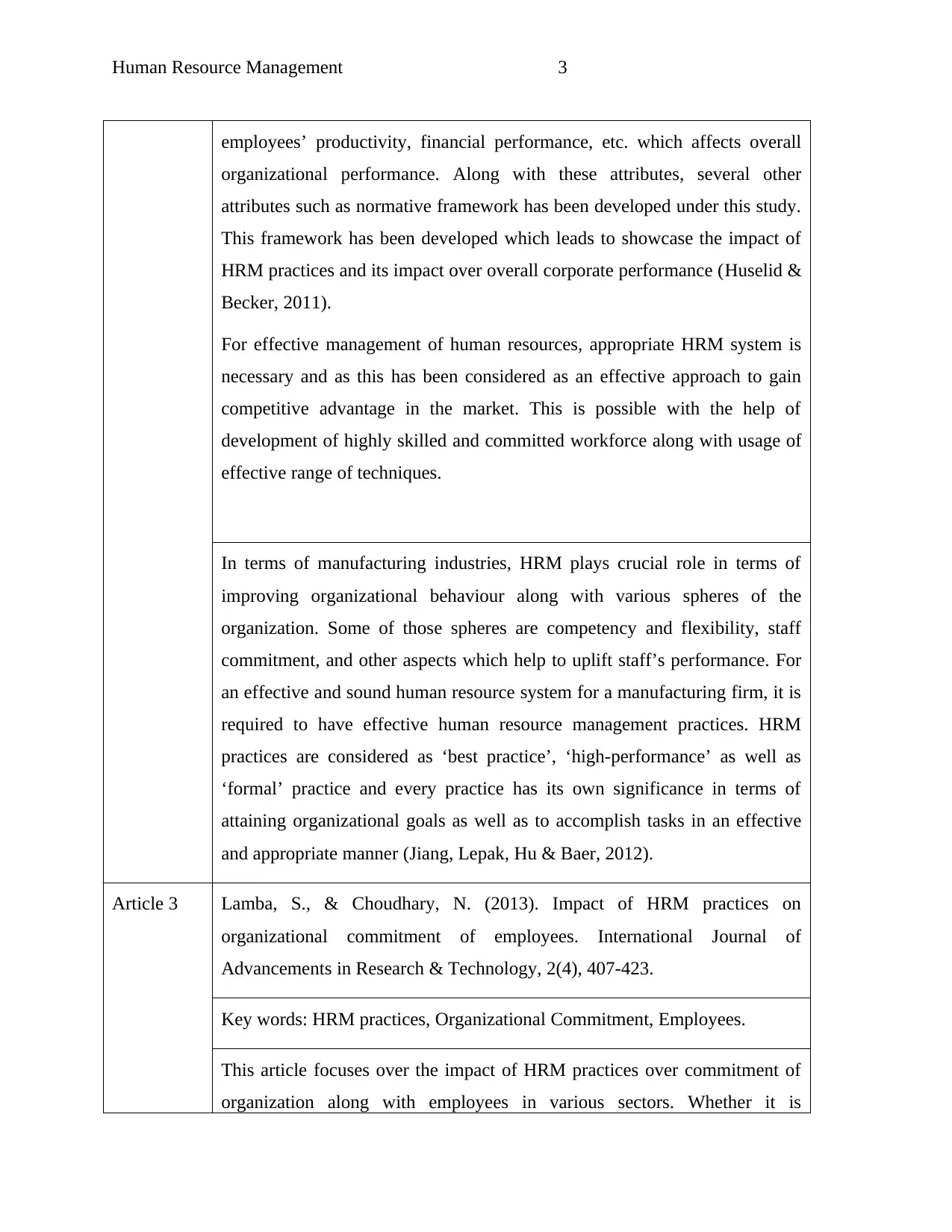
Human Resource Management 3
employees’ productivity, financial performance, etc. which affects overall
organizational performance. Along with these attributes, several other
attributes such as normative framework has been developed under this study.
This framework has been developed which leads to showcase the impact of
HRM practices and its impact over overall corporate performance (Huselid &
Becker, 2011).
For effective management of human resources, appropriate HRM system is
necessary and as this has been considered as an effective approach to gain
competitive advantage in the market. This is possible with the help of
development of highly skilled and committed workforce along with usage of
effective range of techniques.
In terms of manufacturing industries, HRM plays crucial role in terms of
improving organizational behaviour along with various spheres of the
organization. Some of those spheres are competency and flexibility, staff
commitment, and other aspects which help to uplift staff’s performance. For
an effective and sound human resource system for a manufacturing firm, it is
required to have effective human resource management practices. HRM
practices are considered as ‘best practice’, ‘high-performance’ as well as
‘formal’ practice and every practice has its own significance in terms of
attaining organizational goals as well as to accomplish tasks in an effective
and appropriate manner (Jiang, Lepak, Hu & Baer, 2012).
Article 3 Lamba, S., & Choudhary, N. (2013). Impact of HRM practices on
organizational commitment of employees. International Journal of
Advancements in Research & Technology, 2(4), 407-423.
Key words: HRM practices, Organizational Commitment, Employees.
This article focuses over the impact of HRM practices over commitment of
organization along with employees in various sectors. Whether it is
employees’ productivity, financial performance, etc. which affects overall
organizational performance. Along with these attributes, several other
attributes such as normative framework has been developed under this study.
This framework has been developed which leads to showcase the impact of
HRM practices and its impact over overall corporate performance (Huselid &
Becker, 2011).
For effective management of human resources, appropriate HRM system is
necessary and as this has been considered as an effective approach to gain
competitive advantage in the market. This is possible with the help of
development of highly skilled and committed workforce along with usage of
effective range of techniques.
In terms of manufacturing industries, HRM plays crucial role in terms of
improving organizational behaviour along with various spheres of the
organization. Some of those spheres are competency and flexibility, staff
commitment, and other aspects which help to uplift staff’s performance. For
an effective and sound human resource system for a manufacturing firm, it is
required to have effective human resource management practices. HRM
practices are considered as ‘best practice’, ‘high-performance’ as well as
‘formal’ practice and every practice has its own significance in terms of
attaining organizational goals as well as to accomplish tasks in an effective
and appropriate manner (Jiang, Lepak, Hu & Baer, 2012).
Article 3 Lamba, S., & Choudhary, N. (2013). Impact of HRM practices on
organizational commitment of employees. International Journal of
Advancements in Research & Technology, 2(4), 407-423.
Key words: HRM practices, Organizational Commitment, Employees.
This article focuses over the impact of HRM practices over commitment of
organization along with employees in various sectors. Whether it is
Paraphrase This Document
Need a fresh take? Get an instant paraphrase of this document with our AI Paraphraser
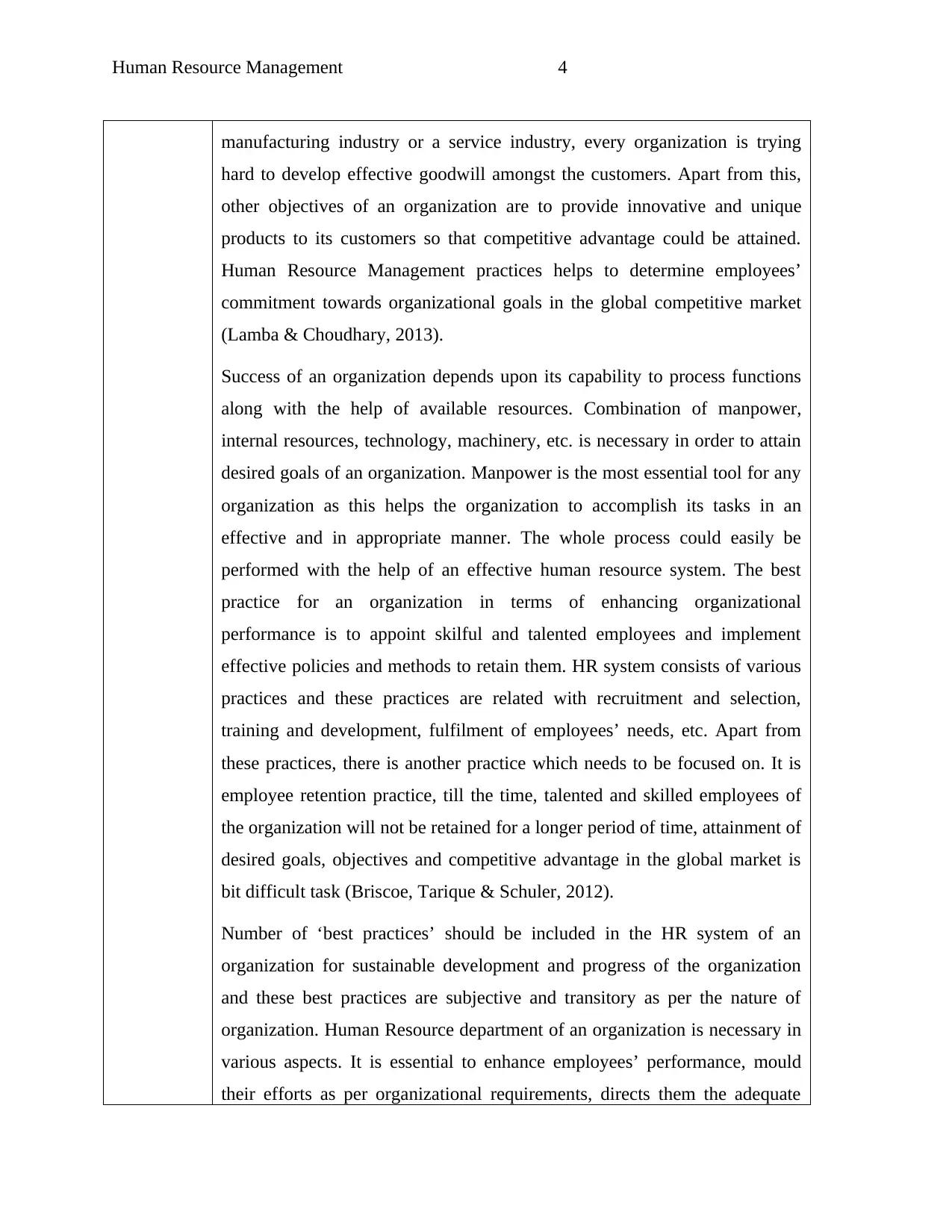
Human Resource Management 4
manufacturing industry or a service industry, every organization is trying
hard to develop effective goodwill amongst the customers. Apart from this,
other objectives of an organization are to provide innovative and unique
products to its customers so that competitive advantage could be attained.
Human Resource Management practices helps to determine employees’
commitment towards organizational goals in the global competitive market
(Lamba & Choudhary, 2013).
Success of an organization depends upon its capability to process functions
along with the help of available resources. Combination of manpower,
internal resources, technology, machinery, etc. is necessary in order to attain
desired goals of an organization. Manpower is the most essential tool for any
organization as this helps the organization to accomplish its tasks in an
effective and in appropriate manner. The whole process could easily be
performed with the help of an effective human resource system. The best
practice for an organization in terms of enhancing organizational
performance is to appoint skilful and talented employees and implement
effective policies and methods to retain them. HR system consists of various
practices and these practices are related with recruitment and selection,
training and development, fulfilment of employees’ needs, etc. Apart from
these practices, there is another practice which needs to be focused on. It is
employee retention practice, till the time, talented and skilled employees of
the organization will not be retained for a longer period of time, attainment of
desired goals, objectives and competitive advantage in the global market is
bit difficult task (Briscoe, Tarique & Schuler, 2012).
Number of ‘best practices’ should be included in the HR system of an
organization for sustainable development and progress of the organization
and these best practices are subjective and transitory as per the nature of
organization. Human Resource department of an organization is necessary in
various aspects. It is essential to enhance employees’ performance, mould
their efforts as per organizational requirements, directs them the adequate
manufacturing industry or a service industry, every organization is trying
hard to develop effective goodwill amongst the customers. Apart from this,
other objectives of an organization are to provide innovative and unique
products to its customers so that competitive advantage could be attained.
Human Resource Management practices helps to determine employees’
commitment towards organizational goals in the global competitive market
(Lamba & Choudhary, 2013).
Success of an organization depends upon its capability to process functions
along with the help of available resources. Combination of manpower,
internal resources, technology, machinery, etc. is necessary in order to attain
desired goals of an organization. Manpower is the most essential tool for any
organization as this helps the organization to accomplish its tasks in an
effective and in appropriate manner. The whole process could easily be
performed with the help of an effective human resource system. The best
practice for an organization in terms of enhancing organizational
performance is to appoint skilful and talented employees and implement
effective policies and methods to retain them. HR system consists of various
practices and these practices are related with recruitment and selection,
training and development, fulfilment of employees’ needs, etc. Apart from
these practices, there is another practice which needs to be focused on. It is
employee retention practice, till the time, talented and skilled employees of
the organization will not be retained for a longer period of time, attainment of
desired goals, objectives and competitive advantage in the global market is
bit difficult task (Briscoe, Tarique & Schuler, 2012).
Number of ‘best practices’ should be included in the HR system of an
organization for sustainable development and progress of the organization
and these best practices are subjective and transitory as per the nature of
organization. Human Resource department of an organization is necessary in
various aspects. It is essential to enhance employees’ performance, mould
their efforts as per organizational requirements, directs them the adequate
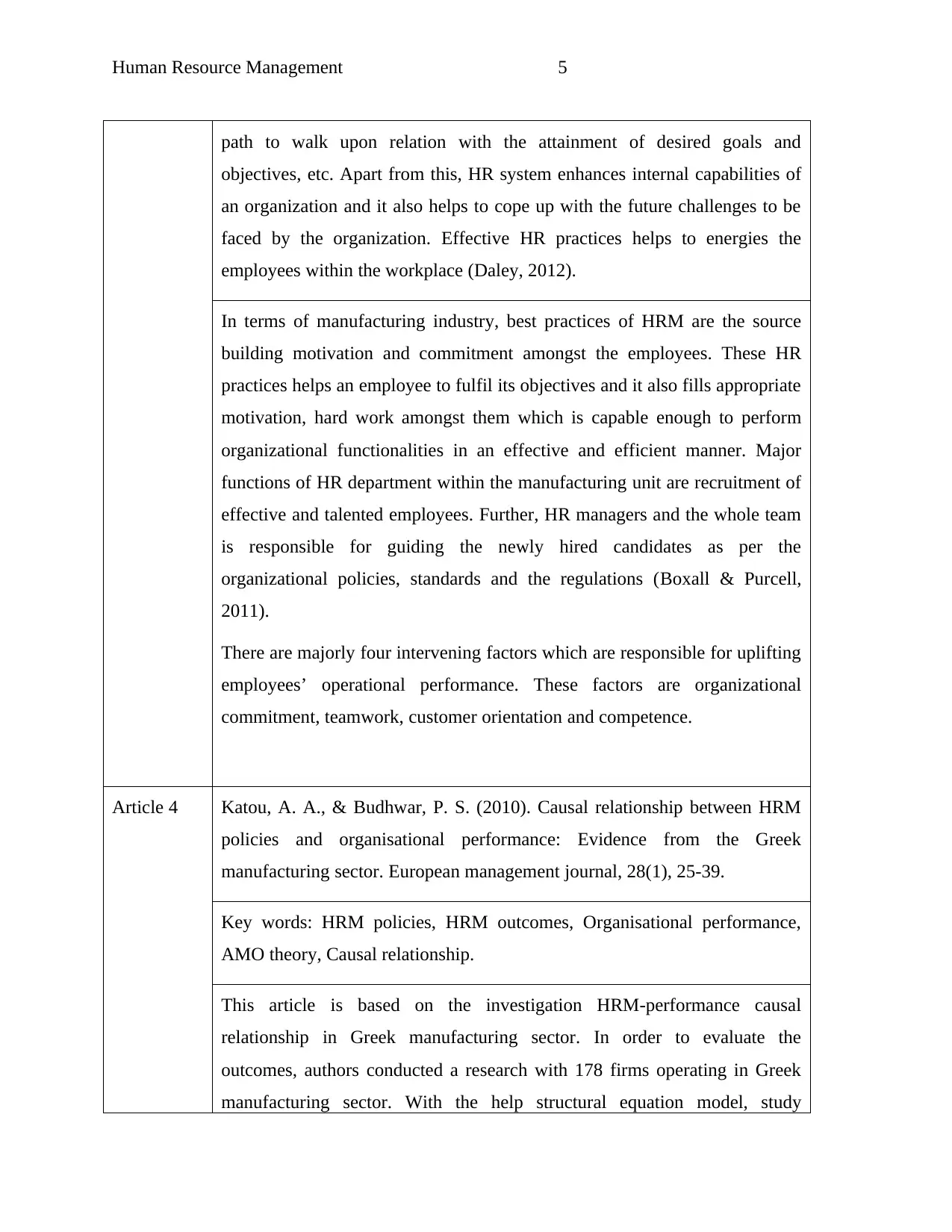
Human Resource Management 5
path to walk upon relation with the attainment of desired goals and
objectives, etc. Apart from this, HR system enhances internal capabilities of
an organization and it also helps to cope up with the future challenges to be
faced by the organization. Effective HR practices helps to energies the
employees within the workplace (Daley, 2012).
In terms of manufacturing industry, best practices of HRM are the source
building motivation and commitment amongst the employees. These HR
practices helps an employee to fulfil its objectives and it also fills appropriate
motivation, hard work amongst them which is capable enough to perform
organizational functionalities in an effective and efficient manner. Major
functions of HR department within the manufacturing unit are recruitment of
effective and talented employees. Further, HR managers and the whole team
is responsible for guiding the newly hired candidates as per the
organizational policies, standards and the regulations (Boxall & Purcell,
2011).
There are majorly four intervening factors which are responsible for uplifting
employees’ operational performance. These factors are organizational
commitment, teamwork, customer orientation and competence.
Article 4 Katou, A. A., & Budhwar, P. S. (2010). Causal relationship between HRM
policies and organisational performance: Evidence from the Greek
manufacturing sector. European management journal, 28(1), 25-39.
Key words: HRM policies, HRM outcomes, Organisational performance,
AMO theory, Causal relationship.
This article is based on the investigation HRM-performance causal
relationship in Greek manufacturing sector. In order to evaluate the
outcomes, authors conducted a research with 178 firms operating in Greek
manufacturing sector. With the help structural equation model, study
path to walk upon relation with the attainment of desired goals and
objectives, etc. Apart from this, HR system enhances internal capabilities of
an organization and it also helps to cope up with the future challenges to be
faced by the organization. Effective HR practices helps to energies the
employees within the workplace (Daley, 2012).
In terms of manufacturing industry, best practices of HRM are the source
building motivation and commitment amongst the employees. These HR
practices helps an employee to fulfil its objectives and it also fills appropriate
motivation, hard work amongst them which is capable enough to perform
organizational functionalities in an effective and efficient manner. Major
functions of HR department within the manufacturing unit are recruitment of
effective and talented employees. Further, HR managers and the whole team
is responsible for guiding the newly hired candidates as per the
organizational policies, standards and the regulations (Boxall & Purcell,
2011).
There are majorly four intervening factors which are responsible for uplifting
employees’ operational performance. These factors are organizational
commitment, teamwork, customer orientation and competence.
Article 4 Katou, A. A., & Budhwar, P. S. (2010). Causal relationship between HRM
policies and organisational performance: Evidence from the Greek
manufacturing sector. European management journal, 28(1), 25-39.
Key words: HRM policies, HRM outcomes, Organisational performance,
AMO theory, Causal relationship.
This article is based on the investigation HRM-performance causal
relationship in Greek manufacturing sector. In order to evaluate the
outcomes, authors conducted a research with 178 firms operating in Greek
manufacturing sector. With the help structural equation model, study
⊘ This is a preview!⊘
Do you want full access?
Subscribe today to unlock all pages.

Trusted by 1+ million students worldwide
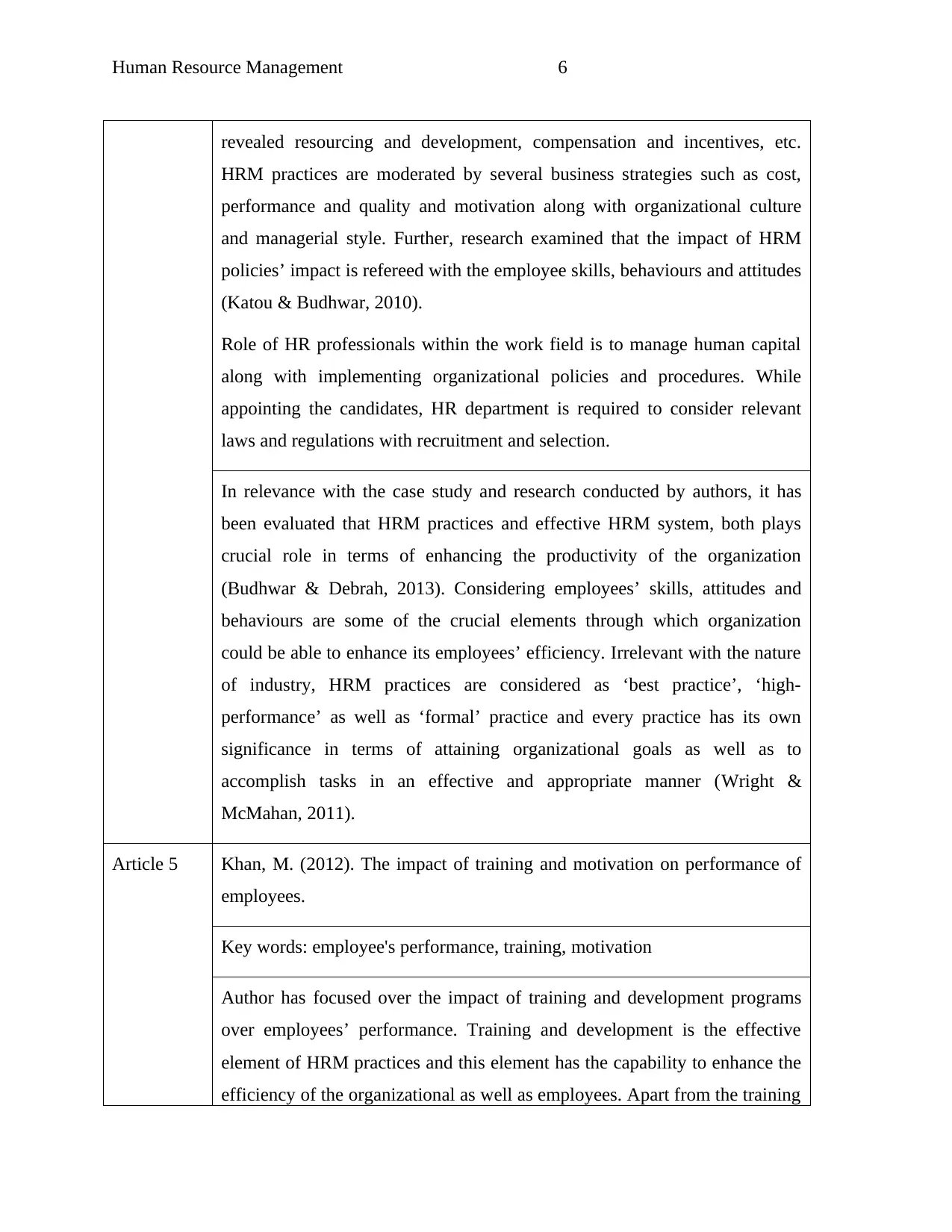
Human Resource Management 6
revealed resourcing and development, compensation and incentives, etc.
HRM practices are moderated by several business strategies such as cost,
performance and quality and motivation along with organizational culture
and managerial style. Further, research examined that the impact of HRM
policies’ impact is refereed with the employee skills, behaviours and attitudes
(Katou & Budhwar, 2010).
Role of HR professionals within the work field is to manage human capital
along with implementing organizational policies and procedures. While
appointing the candidates, HR department is required to consider relevant
laws and regulations with recruitment and selection.
In relevance with the case study and research conducted by authors, it has
been evaluated that HRM practices and effective HRM system, both plays
crucial role in terms of enhancing the productivity of the organization
(Budhwar & Debrah, 2013). Considering employees’ skills, attitudes and
behaviours are some of the crucial elements through which organization
could be able to enhance its employees’ efficiency. Irrelevant with the nature
of industry, HRM practices are considered as ‘best practice’, ‘high-
performance’ as well as ‘formal’ practice and every practice has its own
significance in terms of attaining organizational goals as well as to
accomplish tasks in an effective and appropriate manner (Wright &
McMahan, 2011).
Article 5 Khan, M. (2012). The impact of training and motivation on performance of
employees.
Key words: employee's performance, training, motivation
Author has focused over the impact of training and development programs
over employees’ performance. Training and development is the effective
element of HRM practices and this element has the capability to enhance the
efficiency of the organizational as well as employees. Apart from the training
revealed resourcing and development, compensation and incentives, etc.
HRM practices are moderated by several business strategies such as cost,
performance and quality and motivation along with organizational culture
and managerial style. Further, research examined that the impact of HRM
policies’ impact is refereed with the employee skills, behaviours and attitudes
(Katou & Budhwar, 2010).
Role of HR professionals within the work field is to manage human capital
along with implementing organizational policies and procedures. While
appointing the candidates, HR department is required to consider relevant
laws and regulations with recruitment and selection.
In relevance with the case study and research conducted by authors, it has
been evaluated that HRM practices and effective HRM system, both plays
crucial role in terms of enhancing the productivity of the organization
(Budhwar & Debrah, 2013). Considering employees’ skills, attitudes and
behaviours are some of the crucial elements through which organization
could be able to enhance its employees’ efficiency. Irrelevant with the nature
of industry, HRM practices are considered as ‘best practice’, ‘high-
performance’ as well as ‘formal’ practice and every practice has its own
significance in terms of attaining organizational goals as well as to
accomplish tasks in an effective and appropriate manner (Wright &
McMahan, 2011).
Article 5 Khan, M. (2012). The impact of training and motivation on performance of
employees.
Key words: employee's performance, training, motivation
Author has focused over the impact of training and development programs
over employees’ performance. Training and development is the effective
element of HRM practices and this element has the capability to enhance the
efficiency of the organizational as well as employees. Apart from the training
Paraphrase This Document
Need a fresh take? Get an instant paraphrase of this document with our AI Paraphraser
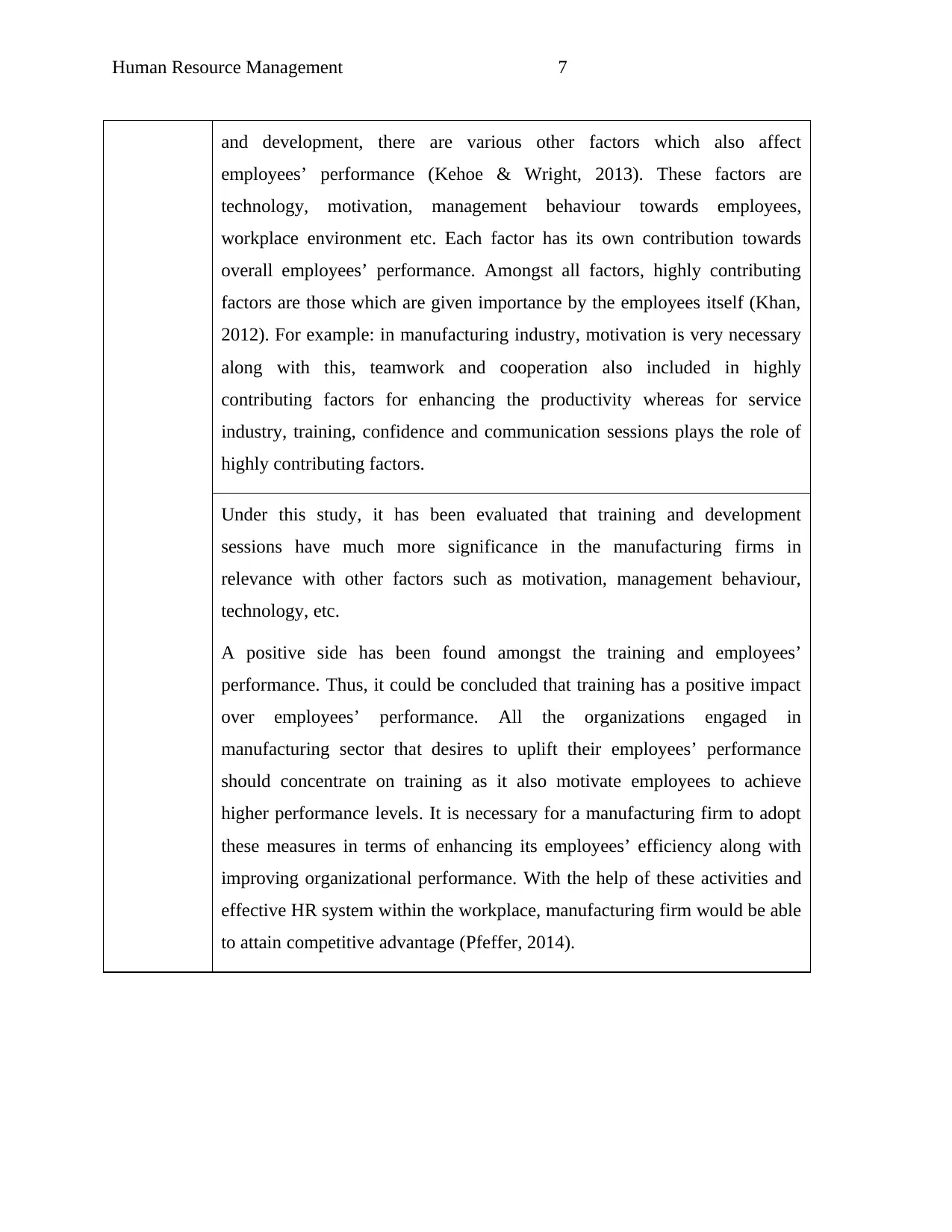
Human Resource Management 7
and development, there are various other factors which also affect
employees’ performance (Kehoe & Wright, 2013). These factors are
technology, motivation, management behaviour towards employees,
workplace environment etc. Each factor has its own contribution towards
overall employees’ performance. Amongst all factors, highly contributing
factors are those which are given importance by the employees itself (Khan,
2012). For example: in manufacturing industry, motivation is very necessary
along with this, teamwork and cooperation also included in highly
contributing factors for enhancing the productivity whereas for service
industry, training, confidence and communication sessions plays the role of
highly contributing factors.
Under this study, it has been evaluated that training and development
sessions have much more significance in the manufacturing firms in
relevance with other factors such as motivation, management behaviour,
technology, etc.
A positive side has been found amongst the training and employees’
performance. Thus, it could be concluded that training has a positive impact
over employees’ performance. All the organizations engaged in
manufacturing sector that desires to uplift their employees’ performance
should concentrate on training as it also motivate employees to achieve
higher performance levels. It is necessary for a manufacturing firm to adopt
these measures in terms of enhancing its employees’ efficiency along with
improving organizational performance. With the help of these activities and
effective HR system within the workplace, manufacturing firm would be able
to attain competitive advantage (Pfeffer, 2014).
and development, there are various other factors which also affect
employees’ performance (Kehoe & Wright, 2013). These factors are
technology, motivation, management behaviour towards employees,
workplace environment etc. Each factor has its own contribution towards
overall employees’ performance. Amongst all factors, highly contributing
factors are those which are given importance by the employees itself (Khan,
2012). For example: in manufacturing industry, motivation is very necessary
along with this, teamwork and cooperation also included in highly
contributing factors for enhancing the productivity whereas for service
industry, training, confidence and communication sessions plays the role of
highly contributing factors.
Under this study, it has been evaluated that training and development
sessions have much more significance in the manufacturing firms in
relevance with other factors such as motivation, management behaviour,
technology, etc.
A positive side has been found amongst the training and employees’
performance. Thus, it could be concluded that training has a positive impact
over employees’ performance. All the organizations engaged in
manufacturing sector that desires to uplift their employees’ performance
should concentrate on training as it also motivate employees to achieve
higher performance levels. It is necessary for a manufacturing firm to adopt
these measures in terms of enhancing its employees’ efficiency along with
improving organizational performance. With the help of these activities and
effective HR system within the workplace, manufacturing firm would be able
to attain competitive advantage (Pfeffer, 2014).
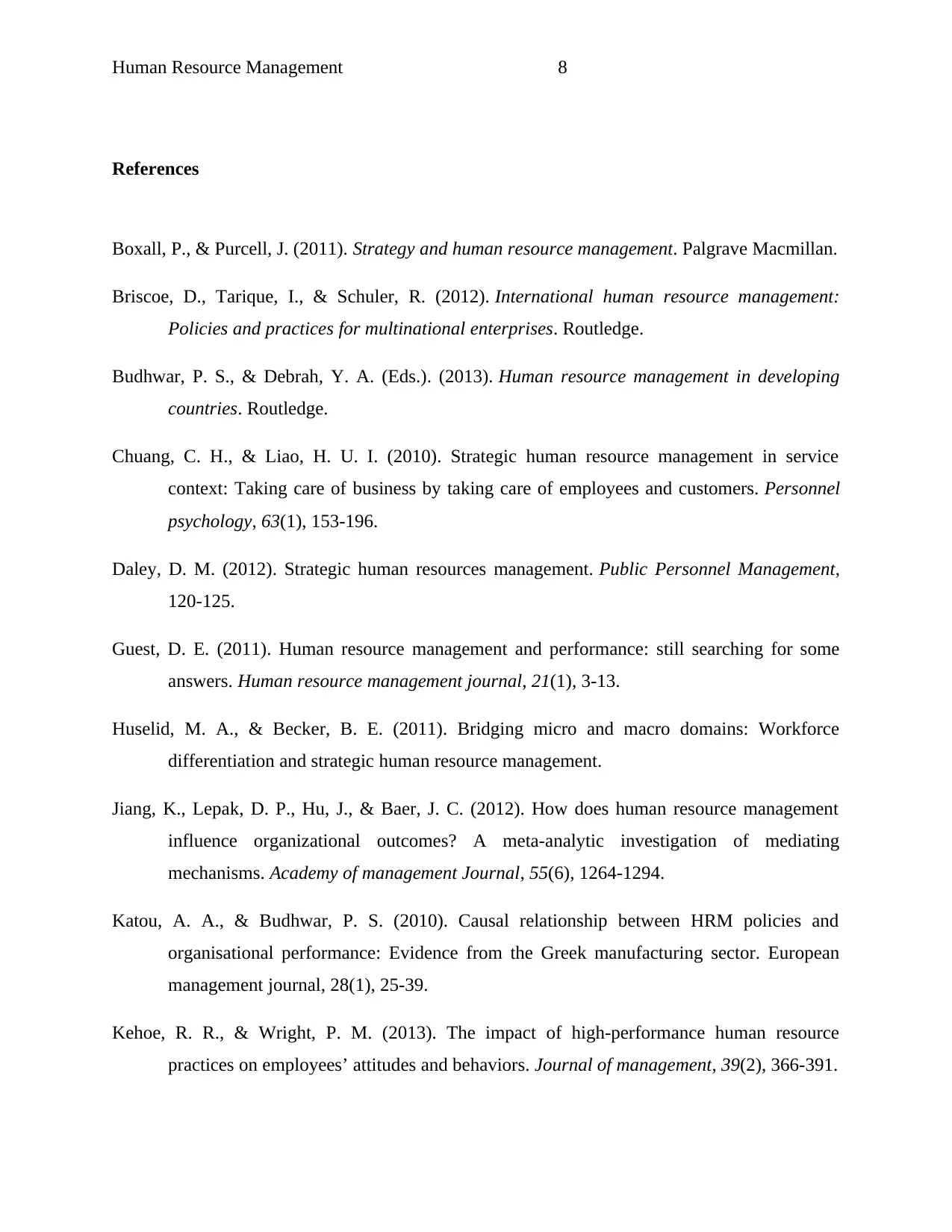
Human Resource Management 8
References
Boxall, P., & Purcell, J. (2011). Strategy and human resource management. Palgrave Macmillan.
Briscoe, D., Tarique, I., & Schuler, R. (2012). International human resource management:
Policies and practices for multinational enterprises. Routledge.
Budhwar, P. S., & Debrah, Y. A. (Eds.). (2013). Human resource management in developing
countries. Routledge.
Chuang, C. H., & Liao, H. U. I. (2010). Strategic human resource management in service
context: Taking care of business by taking care of employees and customers. Personnel
psychology, 63(1), 153-196.
Daley, D. M. (2012). Strategic human resources management. Public Personnel Management,
120-125.
Guest, D. E. (2011). Human resource management and performance: still searching for some
answers. Human resource management journal, 21(1), 3-13.
Huselid, M. A., & Becker, B. E. (2011). Bridging micro and macro domains: Workforce
differentiation and strategic human resource management.
Jiang, K., Lepak, D. P., Hu, J., & Baer, J. C. (2012). How does human resource management
influence organizational outcomes? A meta-analytic investigation of mediating
mechanisms. Academy of management Journal, 55(6), 1264-1294.
Katou, A. A., & Budhwar, P. S. (2010). Causal relationship between HRM policies and
organisational performance: Evidence from the Greek manufacturing sector. European
management journal, 28(1), 25-39.
Kehoe, R. R., & Wright, P. M. (2013). The impact of high-performance human resource
practices on employees’ attitudes and behaviors. Journal of management, 39(2), 366-391.
References
Boxall, P., & Purcell, J. (2011). Strategy and human resource management. Palgrave Macmillan.
Briscoe, D., Tarique, I., & Schuler, R. (2012). International human resource management:
Policies and practices for multinational enterprises. Routledge.
Budhwar, P. S., & Debrah, Y. A. (Eds.). (2013). Human resource management in developing
countries. Routledge.
Chuang, C. H., & Liao, H. U. I. (2010). Strategic human resource management in service
context: Taking care of business by taking care of employees and customers. Personnel
psychology, 63(1), 153-196.
Daley, D. M. (2012). Strategic human resources management. Public Personnel Management,
120-125.
Guest, D. E. (2011). Human resource management and performance: still searching for some
answers. Human resource management journal, 21(1), 3-13.
Huselid, M. A., & Becker, B. E. (2011). Bridging micro and macro domains: Workforce
differentiation and strategic human resource management.
Jiang, K., Lepak, D. P., Hu, J., & Baer, J. C. (2012). How does human resource management
influence organizational outcomes? A meta-analytic investigation of mediating
mechanisms. Academy of management Journal, 55(6), 1264-1294.
Katou, A. A., & Budhwar, P. S. (2010). Causal relationship between HRM policies and
organisational performance: Evidence from the Greek manufacturing sector. European
management journal, 28(1), 25-39.
Kehoe, R. R., & Wright, P. M. (2013). The impact of high-performance human resource
practices on employees’ attitudes and behaviors. Journal of management, 39(2), 366-391.
⊘ This is a preview!⊘
Do you want full access?
Subscribe today to unlock all pages.

Trusted by 1+ million students worldwide
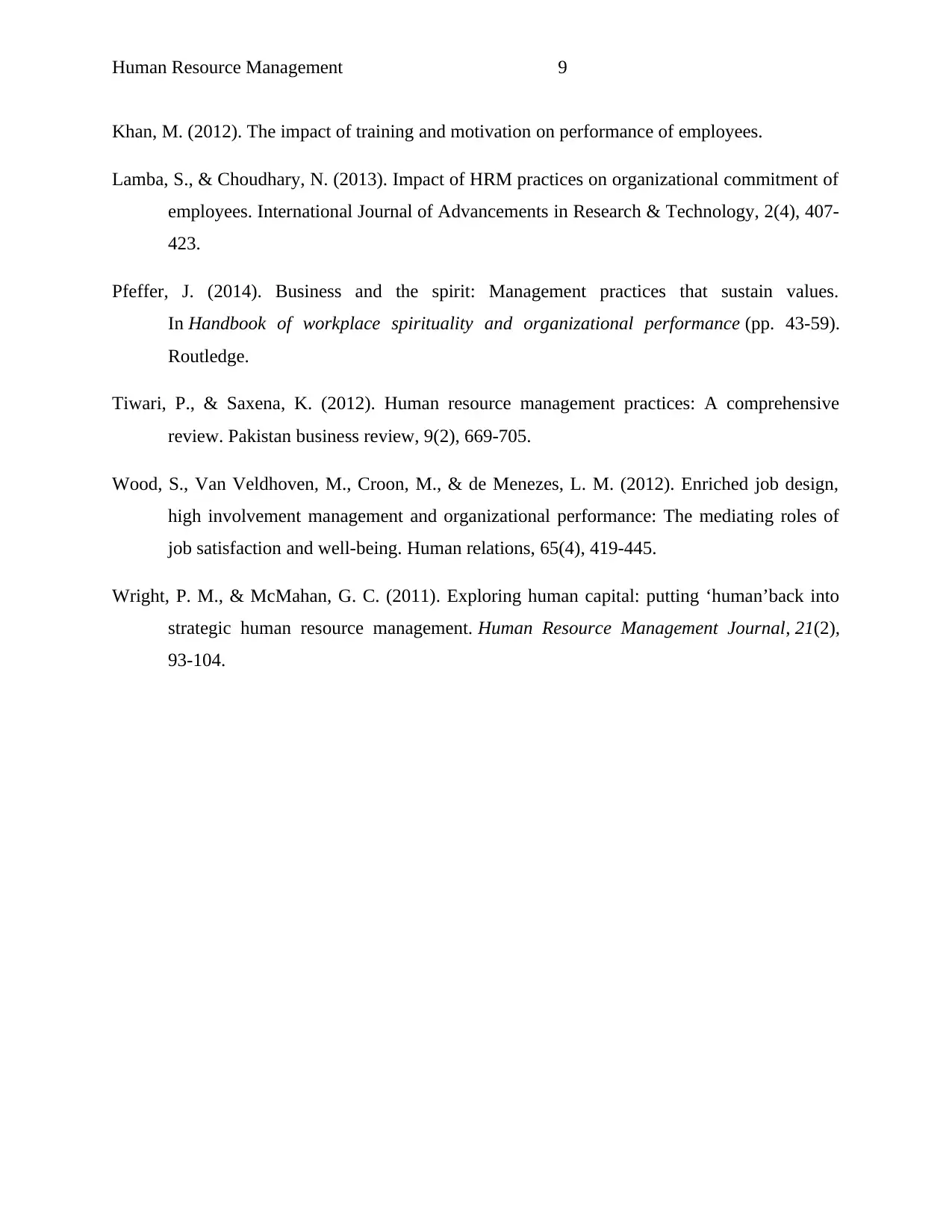
Human Resource Management 9
Khan, M. (2012). The impact of training and motivation on performance of employees.
Lamba, S., & Choudhary, N. (2013). Impact of HRM practices on organizational commitment of
employees. International Journal of Advancements in Research & Technology, 2(4), 407-
423.
Pfeffer, J. (2014). Business and the spirit: Management practices that sustain values.
In Handbook of workplace spirituality and organizational performance (pp. 43-59).
Routledge.
Tiwari, P., & Saxena, K. (2012). Human resource management practices: A comprehensive
review. Pakistan business review, 9(2), 669-705.
Wood, S., Van Veldhoven, M., Croon, M., & de Menezes, L. M. (2012). Enriched job design,
high involvement management and organizational performance: The mediating roles of
job satisfaction and well-being. Human relations, 65(4), 419-445.
Wright, P. M., & McMahan, G. C. (2011). Exploring human capital: putting ‘human’back into
strategic human resource management. Human Resource Management Journal, 21(2),
93-104.
Khan, M. (2012). The impact of training and motivation on performance of employees.
Lamba, S., & Choudhary, N. (2013). Impact of HRM practices on organizational commitment of
employees. International Journal of Advancements in Research & Technology, 2(4), 407-
423.
Pfeffer, J. (2014). Business and the spirit: Management practices that sustain values.
In Handbook of workplace spirituality and organizational performance (pp. 43-59).
Routledge.
Tiwari, P., & Saxena, K. (2012). Human resource management practices: A comprehensive
review. Pakistan business review, 9(2), 669-705.
Wood, S., Van Veldhoven, M., Croon, M., & de Menezes, L. M. (2012). Enriched job design,
high involvement management and organizational performance: The mediating roles of
job satisfaction and well-being. Human relations, 65(4), 419-445.
Wright, P. M., & McMahan, G. C. (2011). Exploring human capital: putting ‘human’back into
strategic human resource management. Human Resource Management Journal, 21(2),
93-104.
1 out of 10
Related Documents
Your All-in-One AI-Powered Toolkit for Academic Success.
+13062052269
info@desklib.com
Available 24*7 on WhatsApp / Email
![[object Object]](/_next/static/media/star-bottom.7253800d.svg)
Unlock your academic potential
Copyright © 2020–2025 A2Z Services. All Rights Reserved. Developed and managed by ZUCOL.




